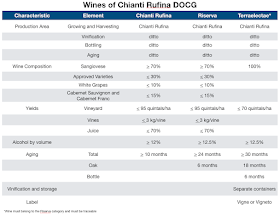Chianti Rufina DOCG, as a subzone of Chianti DOCG, is qualified to produce any of the wines allowed in the appelation.
 |
| Screenshot from consorziovini.it |
The purpose herein is not to explore those broader wines. Rather, it is to explore the wines that are unique to Chianti Rufina. A wine is a Chianti Rufina DOCG on the basis of the physical environment and its adherence to/attainment of the specified production disciplines. I have reported on the physical environment in a previous post and will cover the built environment, the production requirements, and the wines herein.
Chianti DOCG is an appellation built on a Sangiovese foundation; and the same holds true for Chianti Rufina DOCG. The fundamental wine of the region is some mix of Sangiovese (> 70%), approved varieties (< 30%), white grapes (< 10%), and Cabernet Sauvignon and Cabernet Franc (< 15%). A listing of the varieties grown in the appellation is shown below.
 |
 |
| Chianti Rufino map with producers |
While ownerships have changed over time (for the most part), a fair number of these locations have been in the grape-growing business for a minute. For example, grapes have been grown at the Selvapiano location since 1826, at Colognole since 1892, at I Veroni since 1585, etc. Notwithstanding the traditional ages of these estates, they are not hidebound, as almost 50% of the producers are either certified organic or are farming according to organic principles. It should be noted that many of these estates are large, with vineyard space accounting for relatively small shares of the surface area.
The table below illustrates the scope of Chianti Rufina DOCG wines.
Beginning with the 2018 vintage, the Chianti Rufino producers introduced a new tier of wine with the nomenclature Terraelectae, a collective mark of the Consorzia and the associated wine. The wine — requirements illustrated in the table above — was created to "eloquently express the finest qualities of Sangiovese in Tuscany.”
The producers had been exploring ways to achieve a more precise representation of their territorial uniqueness and decided that the way forward was to select their finest quality vineyards exclusively dedicated to Sangiovese — one cru per winery — to produce a wine named after that vineyard. The initial vintage was 2018 with ten participating producers. An additional two producers opted to wait until the 2019 or 2020 vintages to provide their offerings.
Writing in Decanter (Chianti Rufina ups its game with Terraelectae, 11/30/22). Michael Apstein stated that all of the 2018s showed very well. Those initial wines are illustrated below.
Apstein: “If the wines remain high-quality and a unique expression of Sangiovese reflecting the distinctive terroir of Chianti Rufina, the Terraelectae moniker on the label will be useful to customers.”
Writing in Terroir Sense Wine Review (The Magnificent 2019 Chianti Rufina Terraelectae Wine, 4/20/23), Ian D’Agata writes thusly about the sophomore edition of the wines: “I have no recollection of having ever, and I mean ever, tasted a similarly impressive set of new wines such as these 2019 Chianti Rufina Terraelectae wines.”
This is a forceful validation of the Chianti Rufina top-end wine direction from a force within the industry.











